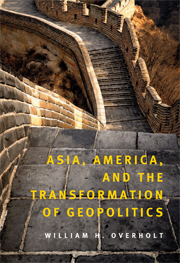Book contents
- Frontmatter
- Contents
- Figures
- Tables
- Preface
- Acknowledgments
- Overview
- CHAPTER ONE Introduction: The Inertia of Foreign Policies
- CHAPTER TWO Cold War Assumptions and Changing Realities
- CHAPTER THREE Regional Trends
- CHAPTER FOUR Asia's Big Powers: Japan and China
- CHAPTER FIVE Smaller Places, Decisive Pivots: Taiwan, Korea, Southeast Asia
- CHAPTER SIX The Aspiring Power and Its Near Abroad: India and South Asia
- CHAPTER SEVEN Russia and Its Near Abroad
- CHAPTER EIGHT The United States and the New Asia
- CHAPTER NINE Scenarios for the Future
- CHAPTER TEN Conclusion
- Bibliography
- Index
CHAPTER TWO - Cold War Assumptions and Changing Realities
Published online by Cambridge University Press: 05 September 2012
- Frontmatter
- Contents
- Figures
- Tables
- Preface
- Acknowledgments
- Overview
- CHAPTER ONE Introduction: The Inertia of Foreign Policies
- CHAPTER TWO Cold War Assumptions and Changing Realities
- CHAPTER THREE Regional Trends
- CHAPTER FOUR Asia's Big Powers: Japan and China
- CHAPTER FIVE Smaller Places, Decisive Pivots: Taiwan, Korea, Southeast Asia
- CHAPTER SIX The Aspiring Power and Its Near Abroad: India and South Asia
- CHAPTER SEVEN Russia and Its Near Abroad
- CHAPTER EIGHT The United States and the New Asia
- CHAPTER NINE Scenarios for the Future
- CHAPTER TEN Conclusion
- Bibliography
- Index
Summary
America's core interests are eternal: security, prosperity, freedom/democracy— for ourselves and others. The U.S. strategy for the Cold War in Asia, like any strategy, was based on choices—choices among these high-priority interests, choices about the tools to be used in achieving these interests, choices about the level of resources to be deployed, choices about how much we emphasize these values for others rather than just ourselves. Under George Washington's No Entangling Alliances strategy, we focused on tending our own garden; if Europeans and Asians chose to slaughter or enslave each other, well, that was their problem. Based on the same interests but a different understanding of the world, the Truman Doctrine and containment made a quite different choice. When President George W. Bush set out to transform the Middle East into a collection of democracies, beginning with the invasion and reform of Iraq, he tilted the emphasis even further.
As we explore the changing strategic architecture of Asia, two perspectives will interact. I shall try to characterize that evolving architecture, including the U.S. position within it. Simultaneously, I shall characterize U.S. policy and U.S. policy choices. These perspectives are analytically separable, but in reality they interact, because since the end of World War II, the United States has had more ability than any other entity to shape Asia's strategic architecture. It would be equally valid to undertake the same analysis from a Chinese or Japanese or Indian perspective, but the motivating concern underlying this essay is for U.S. policy, U.S. choices, and U.S. values.
- Type
- Chapter
- Information
- Asia, America, and the Transformation of Geopolitics , pp. 11 - 32Publisher: Cambridge University PressPrint publication year: 2007

